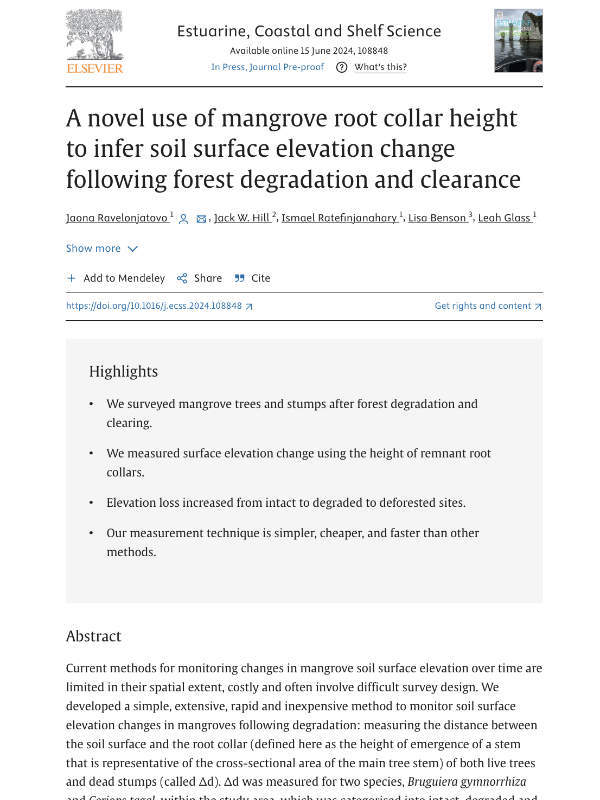Current methods for monitoring changes in mangrove soil surface elevation over time are limited in their spatial extent, costly and often involve difficult survey design. We developed a simple, extensive, rapid and inexpensive method to monitor soil surface elevation changes in mangroves following degradation: measuring the distance between the soil surface and the root collar (defined here as the height of emergence of a stem that is representative of the cross-sectional area of the main tree stem) of both live trees and dead stumps (called Δd). Δd was measured for two species, Bruguiera gymnorrhiza and Ceriops tagal, within the study area, which was categorised into intact, degraded and deforested mangroves in Tsimipaika Bay, Madagascar. A total of 227 subplots, containing 3,066 individual tree stumps and live trees were surveyed within our study site, which spans approximately 4,000 hectares of mangroves. We used a linear model to test relationships between Δd and forest status, species, and live trees or remnant stumps. When measured on B. gymnorrhiza stumps, Δd (cm, mean ± standard error) increased from intact (18.4 ± 2.6) to degraded (24.7 ± 1.5) and finally to deforested mangroves (31.6 ± 0.7), indicating increasing soil elevation loss. A similar pattern did not emerge for C. tagal due to anthropogenic exploitation of their stumps, selectively removing large individuals for charcoal production, thereby confounding estimates of Δd. In addition, we used Δd measurements to construct a spatial analysis of carbon (C) loss following mangrove degradation in the bay. Our analysis predicted a mean C loss of 25.6 Mg C ha-1 (standard error 3.64 x 10-4) representing a lower mean loss value with reduced variability compared to previous Malagasy studies based on limited replicates within deforested areas. Our study demonstrated the use of this simple, yet scientifically rigorous approach to monitor soil elevation loss over time or following severe degradation in mangrove forests. These data facilitate estimates of C emissions from soils and vulnerability to sea level rise when mangroves are degraded. The simplicity and cost-effectiveness of our approach also provide an opportunity to actively involve local communities and practitioners in mangrove management and promote citizen science.
Publications
A novel use of mangrove root collar height to infer soil surface elevation change following forest degradation and clearance

Publication type
Publication year
2024
Download size
<1mb
Citation
Jaona Ravelonjatovo, Jack W. Hill, Ismael Ratefinjanahary, Lisa Benson, Leah Glass
Share this:
Facebook
Twitter
LinkedIn
WhatsApp
Email
Related publications
Join a global movement
















